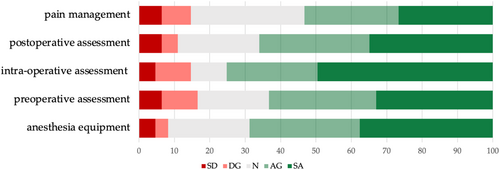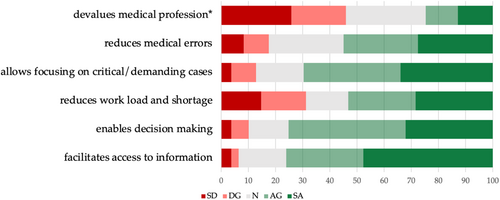Perspectives toward the application of Artificial Intelligence in anesthesiology-related practices in Saudi Arabia: A cross-sectional study of physicians views
Abstract
Background and Aims
The use of Artificial Intelligence (AI) relies on computer science and large datasets, with the technology mimicking human intelligence as it makes logical decisions. This study aims to assess the perceptions and experiences of anesthesiology practitioners toward AI and identify its benefits to healthcare professionals and patients, along with current and future applications of AI.
Methods
This cross-sectional descriptive online survey study was disseminated to physicians who work in anesthesiology practice in Saudi Arabia. Descriptive statistics were used to report the characteristics of the respondents and summarize the results of the survey.
Results
There were 109 responses, with 85.32% being male, 35.78% being aged 40–49 years, and 69.72% being consultant anesthesiologists. The majority of participants (73.39%) believed that AI could be used in multiple settings related to anesthesiology practice. Participants also believed that AI could facilitate access to data (76.15%), enable precise decision-making (75.23%), reduce medical errors (55.04%), reduce workload and shortage of healthcare personnel (53.21%), and allow healthcare personnel to focus on more demanding cases (69.72%). In addition, the majority of participants believed that AI can be beneficial to patients, in which 69.72% believed that AI can improve patient access to care, 77.06% believed that AI can facilitate patient education, and 65.14% believed that AI can guide patients during treatment. Lastly, 70.64% believed that AI would be beneficial to anesthesiology practices in the future. However, 61.47% claimed that their workplace has no plan for adopting AI.
Conclusions
The anesthesiologists showed generally positive attitudes towards AI, in spite of its limited utilization and implementation challenges. Strong beliefs exist about AI's future potential in anesthesia care and postgraduate education.
1 INTRODUCTION
In an era of continuous technological advancement, one particular field has been experiencing an incredibly rapid rate of development—Artificial Intelligence (AI). It is generally defined as a technological field that incorporates both computer science and expansive datasets and is capable of making logical decisions based on input data in a manner that mimics human intelligence. Its capabilities also extend to visual perception, speech recognition, problem-solving, and natural language understanding.1 Various industries are already utilizing AI, and its potential for the future of healthcare is promising. In the continuously progressing landscape of medicine, anesthesiology stands out as a receptive field to cutting-edge technological advancements, with AI potentially leading its course.
Anesthesiology is a specialized field of medicine concerned with pain relief and surgical patient care during the perioperative period.2 The use of technology is integral to the work of anesthesiologists; however, the extent to which artificial intelligence can support them in delivering optimal patient care remains a topic of ongoing discussion. Moreover, anesthesiology specialists attitudes and perspectives on AI implementation in their practice remain unclear.
AI's integration into medicine has the ability to transform patient care, offering accurate disease detection, personalized treatment plans, and real-time decision support. Additionally, it expedites drug discovery, enhances chronic disease management, and revolutionizes medical research, leading to better disease understanding and improved healthcare outcomes.3 Current applications of AI in healthcare include surgical robotics, medical imaging analysis, smart Internet of Things (IoT) devices, signal, and in vitro diagnostic analysis.4
In anesthesiology, most recent AI developments aid but do not replace anesthesiologists. For instance, AI's ability to natural language processing (NLP) could help anesthesiologists better analyze free text to document postoperative complications or predict adverse events.5-7 In addition, studies have demonstrated that AI can assist in monitoring the depth of anesthesia, controlling anesthesia delivery, providing ultrasound guidance, managing pain, and providing logistical support in the operating room.8 A study sought to investigate anesthesiologists’ knowledge about AI and their perspectives on the introduction of AI-based technologies into the clinical setting, and most anesthesiologist reported that there is a need for more education and training in the field of AI.9 Despite agreeing on the usefulness of AI in the medical field, most health professionals in a study done in the United Kingdom lack an understanding of the principles of AI and are concerned about the potential consequences of its widespread use in clinical practices.10 Another study revealed that healthcare professionals were less inclined to adopt AI in healthcare if they did not understand its potential to enhance patient care. However, the fear of AI replacing professionals in the healthcare setting was not a prominent concern among these participants.11
Recently, Saudi Arabia has established the Saudi Data and Artificial Intelligence Authority (SDAIA) to support AI agenda within the kingdom. The SDAIA launched numerous initiatives to support various governmental sectors, including the healthcare sector. So far, Saudi Arabia has implemented many AI-driven projects in the healthcare sector, such as the development of different health mobile applications, telemedicine services, and electronic medical health record systems.12 AI is therefore expected to play an increasingly important role in perioperative medicine in the very near future. In this context, however, little is known about anesthesiologists’ knowledge and attitude toward AI. This is important because AI plays a significant role in national healthcare transformation, and the successful introduction of new technologies depends on the understanding and cooperation of their end users. Therefore, this study aims to better understand the awareness and attitudes of anesthesiology specialists in Saudi Arabia towards the integration of AI into their work.
2 MATERIALS AND METHODS
2.1 Study design and participants
This is a descriptive, cross-sectional study that surveys all anesthesiology specialists working in Saudi Arabia from July to August 2023, despite their age, gender, level of training, and years of experience. Anesthesia specialists working at different hospitals in Saudi Arabia were invited to participate in this study. The inclusion criteria include both male and female anesthesiology residents, fellows, assistants, and consultants from all nationalities. This study was conducted in accordance with the Strengthening the Reporting of Observational Studies in Epidemiology (STROBE) guidelines for cross-sectional studies (Supporting Information File 1).13
2.2 Procedure and sample size
The survey was constructed online using Google Forms. It was sent anonymously to anesthesia specialists through WhatsApp. An informed consent was obtained from all participants before their participation. Ethical approval was obtained from the Institutional Review Board in King Abdullah International Medical Research Centre (approval number: IRB/2027/23). Due to the nature of the study being exploratory, a sample size calculation was not performed.
2.3 Instrument and data collection
In this study, data were collected through an online English questionnaire using previously validated surveys.14-16 It is composed of three sections, including demographics, knowledge/application of AI, and perceptions/opinions of AI. A 5-point Likert scale (from strongly agree to strongly disagree). Perception/opinion statements were classified into positive and negative statements. Perception statements were also further classified based on three themes: uses of AI, benefits/drawbacks of AI integration to practitioners, and benefits/drawbacks of AI integration to patients.
2.4 Data analysis
A descriptive analysis approach was used to summarize the findings of this study. Categorical data were expressed using frequency and percentages. IBM Statistical Package for the Social Sciences (SPSS) version 28 (IBM Corp., Armonk, NY, USA) was used for data analysis.
3 RESULTS
3.1 Characteristics of participants
Overall, 109 physicians responded to the survey, of whom 68 (62.38%) were working in King Abdulaziz Medical City (KAMC), 15 (13.76%) were working in King Khalid University Hospital, and 26 (23.85%) were working in different hospitals across Saudi Arabia. Ninety-three of the participants (85.3%) were males, and 16 (14.7%) were females. Most of the respondents were in the 40–49 year age group (35.8%). 26.6% of the respondents had ≤5 years of experience, followed by 25 (22.9%) respondents had ≥20 years of experience, 22 (20.2%) respondents had 16–20 years of clinical experience, 21 (19.3%) had 11–15 years of clinical experience, and 12 (11.0%) had 6–10 years of clinical experience. The majority of respondents were consultants (69.7%) (Table 1).
| Variable | All cohort (n = 109) |
|---|---|
| Age groups, years | N (%) |
| 20–29 | 22 (20.2) |
| 30–39 | 24 (22.0) |
| 40–49 | 39 (35.8) |
| 50–59 | 13 (11.9) |
| More than 60 | 11 (10.1) |
| Gender | |
| Male | 93 (85.3) |
| Female | 16 (14.7) |
| Level of experience | |
| Consultant | 76 (69.7) |
| Non-Consultant | 33 (30.3) |
| Years of experience | |
| ≤5 | 29 (26.6) |
| 6–10 | 12 (11.0) |
| 11–15 | 21 (19.3) |
| 16–20 | 22 (20.2) |
| ≥20 | 25 (22.9) |
3.2 On the use of AI
As shown in Figure 1, the majority (73.39%) believe AI can be utilized in multiple settings, including monitoring the depth of anesthesia, controlling anesthesia delivery, predicting airway difficulties, etc. Furthermore, the majority believed it could be integrated into various anesthesia equipment (68.80%), in preoperative assessment (63.31%), intraoperatively (75.23%), postoperatively (66.05%), and in pain management (53.22%).

3.3 Benefits of AI to healthcare professionals
Most of the participants agreed that AI facilitates access to data (76.15%), enables precise decision making (75.23%), reduces medical errors (55.04%), decreases workload and shortage of healthcare professionals (53.21%), and hence allows them to focus on demanding cases (69.72%). Moreover, 45.87% believed that AI does not devalue the medical profession (Figure 2).

3.4 Benefits of AI to patients
The majority agreed that AI can improve patients’ access to care (69.72%), facilitate their education (77.06%), and guide them during treatment (65.14%) without violating their privacy or confidentiality (41.29%). The respondents equally agreed (38.53%) and disagreed (38.54%) on AI's negative impact on patients’ relationships with practitioners (Figure 3).

3.5 Future of AI in anesthesiology practice
As demonstrated in Figure 4, most respondents believed AI would be more reliable and accurate (70.64%) and beneficial in anesthesiology practices (70.64%) in the future. Additionally, most agreed that AI should be part of the postgraduate program (77.99%). Yet, 82.57% think AI should be gradually implemented, and 45.87% had concerns about AI replacing anesthesiologists’ jobs.

3.6 Current use of AI
As shown in Figure 5, A remarkable number of participants (87.16%) reported lacking an expert team for AI, and 76.15% not incorporating AI in their daily practice. However, participants reported that the main limitation to AI implementation was a lack of an expert team (54.13%) and the necessary skills for its application (53.21%). The majority (61.47%) also claimed that their workplace has no plan for applying AI.

4 DISCUSSION
This study surveys anesthesiology specialists in Saudi Arabia about their perceptions and attitudes toward AI use in perioperative practice. Survey results show that anesthesiologists have general knowledge and a growing interest in AI technology. In particular, our findings highlight that anesthesiologists have positive attitudes toward AI applications in multiple perioperative settings. In addition, they believed that integrating AI into the healthcare system (e.g., data access, decision-making) would benefit healthcare professionals in making better-informed decisions on patient care. The findings also show that most of the anesthesiologists had a positive perception of AI in improving patient experience of care. These underline the broader positive attitude towards AI integration in clinical practice, which is in line with previous studies.17-20
AI has been widely studied among students19 and clinicians17 who acknowledged its potential and engaged, to variable extents, in using AI. The current study showed a predominant response from male anesthesiologists, highlighting the variation and disparity of the sample. Although the findings show similar AI engagement between genders, this imbalance indicates a requirement for comprehensive AI education that would include a wide range of perspectives and needs. These findings are highlighted by Estrada Alamo CE et al. who reported that survey takers were male (71%). The survey includes variable professional experience levels ranging from 5 to over 21 years. Consultants and highly experienced professionals had a particular focus on the reliability of applying AI in perioperative care. Our findings are in line with Poncette AS, et al. results which reported the skepticism of ICU physicians about AI-integrated monitors that made increased rates of false-positive alarms.21 Conversely, the specialists who had less experience showed higher personal engagement with AI use, despite the lack of formal training. These findings underscore the critical need to formulate policies and guidelines that govern AI adoption in clinical settings.
The survey responses show a positive attitude, even strong endorsement in some responses, to AI integration and its potential to help anesthesiologists overcome clinical challenges. The majority (73.39%) believe that AI can be utilized in multiple settings, including monitoring the depth of anesthesia, controlling anesthesia delivery, and predicting of airway difficulties. This perception of AI stems from its capacity to process raw data, through instantaneously predictive analysis, into applicable plans that improve patient outcomes.22, 23 Furthermore, AI technology, when fed by big data, can mitigate potential risks and provide recommendations that streamline to care providers’ decisions.24-26 Such pragmatic applications have been investigated in the literature by various disciplines such as radiology, surgery, dermatology, and oncology.27-30 For instance, AI models can address the limitations of traditional methods (e.g., traditional clinical decision support tools) by utilizing livestreaming intraoperative and electronic health record (EHR) data. These models can enhance surgical decision-making across the preoperative, intraoperative, and postoperative stages of care.31
The current study demonstrated that awareness and basic comprehension of AI applications in clinical practice were moderate among anesthesiologists. The participants’ responses about their understanding of AI were mostly middle scores (34.86%). Working with AI followed similar trends. This highlights that anesthesiologists had basic experience with AI applications, however, a variable depth of knowledge was demonstrated among the participants. This inconsistency indicates that anesthesiologists might benefit from uniform training and targeted enhancement for the proper utilization of AI. Especially for developing anesthesiologists who may gain the most from AI integration in their education through their residency.32, 33 This survey reported that 76.15% of participants had no standardized training or formal guidance in AI. This majority has gained exposure to AI applications predominantly through personal initiatives and self-education, which is not enough to narrow the knowledge gap for AI applications.34 It is therefore necessary to enhance the development of structured training programs that are included into the undergraduate curriculum. Future training programs should prioritize developing proficiency in AI integration in the workplace and be tailored to the specific requirements of the anesthesiology field.
5 LIMITATIONS
This study has several limitations. First, the relatively small sample size and limited number of clinical sites included in this study may not entirely reflect the anesthesiologist's perceptions towards AI, which contributes to potential sampling error and limits the generalizability of the findings. Second, the questionnaire distribution method may introduce selection bias due to the relatively small number of female respondents. The underrepresentation of the female gender in the current study may therefore limit the generalizability of the findings; therefore, they should be interpreted with caution. Third, the selection of participants using non-probability convenience sampling method might have affected the representativeness of our sample and limited the generalizability of our results. Future research is therefore needed to validate these findings in larger, diverse, and randomly selected participants. Finally, this survey lacked questions that investigate the ethical aspect of using AI in a perioperative setting, which is an essential scope of anesthesiologists perceptions towards AI integration. This is a key requirement for policymakers to develop regulatory procedures to oversee AI use in clinical settings.35-37 Future work may expand the survey scope as well as the clinical sites included in the survey.
6 CONCLUSIONS
Despite the promising future this technology holds, the healthcare industry is still hesitant to adopt and utilize AI. This study recommends the gradual and careful implementation of AI into healthcare practices, taking ethical considerations into account. This study also suggests teaching AI as part of postgraduate programs and provide professional training for AI in clinical settings. For future research, an in-depth analysis of the impact of secondary factors, such as age and gender, on healthcare practitioners perceptions of AI is encouraged.
ACKNOWLEDGMENTS
This research did not receive any specific funding. Special thanks to respondents from the department of anesthesia in all hospitals for their participation in the questionnaire.
AUTHOR CONTRIBUTIONS
Mohammed Al Harbi: Conceptualization; Methodology; Supervision; Writing—review and editing; Writing—original draft. Ahmed Alotaibi: Visualization; Writing—original draft. Amal Alanazi: Conceptualization; Formal analysis; Resources; Writing—original draft. Fatimah Alsughayir: Conceptualization; Methodology; Writing—original draft. Deema Alharbi: Conceptualization; Formal analysis; Methodology; Writing—original draft. Ahmad Bin Qassim: Conceptualization; Methodology; Resources; Writing—original draft. Talal Alkhwaiter: Conceptualization; Formal analysis; Methodology; Resources; Writing—original draft. Lafi Olayan: Writing—original draft; Writing—review and editing. Manal al Zaid: Writing—original draft; Writing—review and editing. Mohmad Alsabani: Methodology; Supervision; Writing—review and editing; Writing—original draft.
CONFLICT OF INTEREST STATEMENT
The authors declare no conflict of interest.
TRANSPARENCY STATEMENT
The lead author Mohmad Alsabani affirms that this manuscript is an honest, accurate, and transparent account of the study being reported; that no important aspects of the study have been omitted; and that any discrepancies from the study as planned (and, if relevant, registered) have been explained.
Open Research
DATA AVAILABILITY STATEMENT
The data set is not publicly available. Formal and reasonable requests to access the data set should be directed to the corresponding author. The data that support the findings of this study are available from King Abdullah International Medical Research Center. Restrictions apply to the availability of these data, which were used under license for this study. Data are available from the author(s) with the permission of King Abdullah International Medical Research Center.




